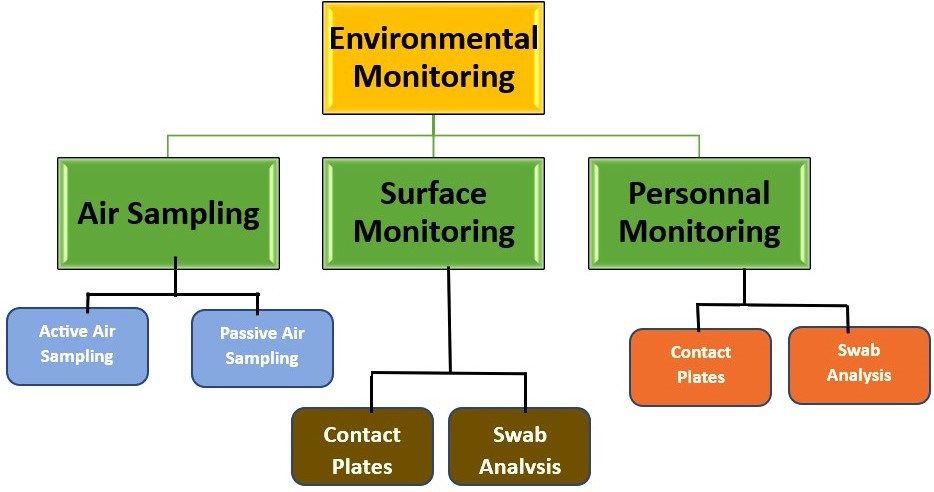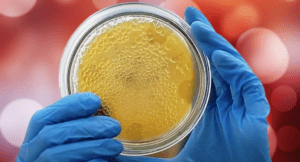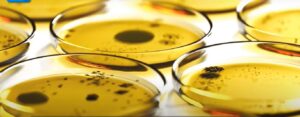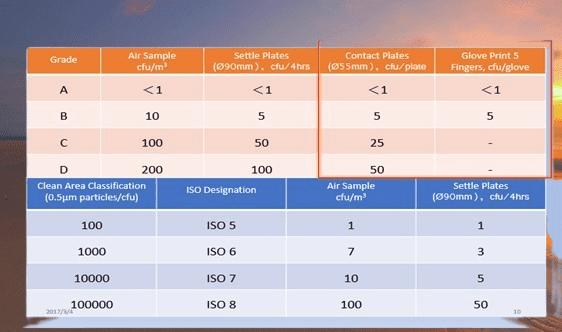Environmental Monitoring In Pharma Industry means the process of regularly testing and analyzing the air, water, surfaces, and equipment of the manufacturing plant of the pharmaceutical facility. This is to ensure that the environment is free from contamination that could potentially compromise the quality, safety, and efficacy of the drugs being produced. This area’s monitoring is critical to maintaining Good Manufacturing Practices (GMPs) and ensuring that the pharmaceutical products are consistently produced to meet the required standards. The monitoring process involves taking samples and testing for microorganisms such as bacteria, fungi, and viruses that could potentially contaminate the products. The results of the testing are used to identify any potential sources of contamination and to implement corrective actions to prevent or eliminate it.
Environmental Monitoring In Pharma Industry is a regulatory requirement for pharmaceutical product manufacturers and is usually conducted in cleanrooms and other controlled areas. It is an essential part of quality control and assurance, and it helps to ensure that the drugs produced are safe and effective for use by patients.
The processes are followed in the Environmental Monitoring In Pharma Industry.
The processes of area monitoring or Environmental Monitoring In Pharma Industry will be carried out in the following steps
- Identification of the areas to be monitored: This involves determining the critical areas within the manufacturing facility where the risk of contamination is highest. These areas usually include cleanrooms, filling lines, and other production areas.
- Selection of monitoring methods: Different methods can be used to monitor different areas, including active air sampling, passive air sampling, surface sampling, and personnel monitoring. The selection of the method depends on the type of the area to be monitored, the size of the area, and the level of risk.
- Setting up the monitoring equipment: Once the monitoring methods have been selected, the equipment needed for monitoring is set up. This includes air samplers, particle counters, and microbial monitors.
- Conducting the monitoring: Monitoring is usually carried out during routine production activities, and samples are taken at predetermined intervals. The samples are then analyzed in a laboratory to determine the level of contamination.
- Data analysis and interpretation: The data collected during monitoring is analyzed, and any trends or patterns that indicate a potential problem are identified. The data is also compared to established limits and criteria to determine whether the area meets the required standards.
- Corrective action: If the monitoring reveals a problem, corrective action is taken to address the issue. This may involve cleaning and sanitizing the affected area, changing procedures, or adjusting equipment.
- Documentation and reporting: All monitoring activities and results are documented and reported to ensure a record of the monitoring process and any corrective actions are taken. This documentation is also used to demonstrate compliance with regulatory requirements.
These above are also called 7 steps process of Environmental Monitoring In Pharma Industry.

Benefits of Environmental Monitoring In Pharma Industry
Environmental Monitoring In Pharma Industry has various advantages for the pharmaceutical sector, our blog explains every aspect step by step as follows:
- Ensuring product quality: Environmental monitoring aids in locating and eliminating potential contamination sources, guaranteeing that the pharmaceutical items produced are of the highest quality standards and secure for patient usage.
- Adherence to regulatory standards: Environmental monitoring is a need for pharmaceutical producers, and compliance with these requirements helps to guarantee that the facility complies with the regulations of organizations like the FDA.
- Early problem detection: Frequent environmental monitoring can assist in seeing possible concerns before they become significant ones, enabling fast corrective action to be performed.
- Lower risk of product recalls: Environmental monitoring can help to lower the risk of product recalls, which can be expensive and damaging to a company’s brand. Environmental monitoring can do this by identifying and regulating potential sources of contamination.
- Enhanced operational effectiveness: Environmental monitoring ensures that production processes run at peak efficiency, lowering the possibility of production delays or downtime caused by pollution problems.
- Enhance worker safety: Environmental monitoring enables the identification of potential workplace risks, such as exposure to dangerous chemicals or microbes, and enables the implementation of the necessary safeguards to protect workers from these risks.
- Increased customer satisfaction: Environmental monitoring can help to increase customer satisfaction and trust in the company’s products by ensuring that pharmaceutical items are of high quality and safe for patient usage.
these above are the advantages or benefits of Environmental Monitoring In Pharma Industry.

Factors that Impact Environmental Monitoring In Pharma Industry
There are several factors that need to be considered during EEnvironmental Monitoring In Pharma Industry. These include the following key points:
- Facility design: The design of the facility and the cleanroom should be optimized to minimize the risk of contamination, including the type of HVAC system, the layout of the facility, and the materials used in construction.
- Environmental conditions: The environmental conditions within the facility, including temperature, humidity, and air pressure, should be carefully controlled to minimize the risk of contamination and ensure that the production processes operate optimally.
- Personnel behavior: Personnel working within the facility can be a significant source of contamination. Therefore, their behavior should be carefully monitored and controlled through appropriate training, gowning procedures, and hygiene practices.
- Equipment and materials: All equipment and materials used in the production process should be regularly cleaned and sanitized to minimize the risk of contamination.
- Sampling methods: The methods used for environmental sampling should be carefully selected and validated to ensure they are appropriate for the specific environment being monitored.
- Analytical methods: The analytical methods used for sample analysis should be validated to ensure that they are sensitive and specific enough to detect any potential contaminants.
- Data analysis and interpretation: The data collected during monitoring should be analyzed and interpreted by experienced personnel to identify any trends or patterns that indicate a potential problem.
- Corrective action: Any issues identified during monitoring should be addressed promptly through appropriate corrective action, which should be documented and reported.
- Regulatory requirements: All environmental monitoring activities should be conducted in compliance with applicable regulatory requirements, including those established by the FDA and other regulatory bodies.
Overall, environmental monitoring should be viewed as a critical component of quality control in the pharmaceutical industry, and careful attention should be paid to all factors that can impact the accuracy and reliability of the monitoring process in the Environmental Monitoring In Pharma Industry.
Environmental Monitoring In Pharma Industry by microbiological methods
A technique for proving the microbiological quality of a controlled environment and quickly spotting changes is microbiological environmental monitoring. It entails compiling information based on the number of microorganisms found in the air, surfaces, and people. These samples are gathered from the cleanroom region and taken outside the airlock.
Pharmaceutical sterile items like injections, infusions, and ophthalmic solutions, as well as non-sterile products like solutions, capsules, tablets, and ointments, are made safe and effective by microbiological testing when accompanied by stringent environmental monitoring. In order to comply with regulations, environmental monitoring is necessary for the GMP procedure. It is required for the release of the finished product.
All Environmental Monitoring In Pharma Industry programs should use a combination of the following techniques, per Pharmacopoeia guidelines:
- Surface Monitoring.
- Personal Monitoring.
- Passive Air Sampling.
- Active Air Sampling.
Because airborne microorganisms raise the possibility of components and products becoming contaminated, it’s crucial to keep an eye on the air quality in any lab or manufacturing location. The CDC lists bacteria, fungi, viruses, pollen, and particles as biological pollutants in the air. Air is sampled using active air sampling and passive air sampling techniques for viable particles, and laser particle counters for non-viable particles.
Air Sampling Active
In this procedure, a predetermined volume of cleanroom air is collected using an air sampler and placed on a petri dish containing culture material. The plates are then incubated for the necessary amount of time and temperature after the sample is complete.
A sampling of Passive Air
In this procedure, the settle plates are exposed to the air for a predetermined amount of time. Next, similar to active air sampling, when the sampling is finished, the plates are incubated for the necessary length of time and temperature.

Surface Monitoring & Observation
Microorganisms can swiftly spread from one surface to another by air, touching the surface with something contaminated, regardless of how well a lab or cleanroom has been disinfected. Swab analysis and Contact Plates are used for Surface Monitoring.
Contact Plates Available Now To collect samples from a surface area of approximately 25 cm2, utilize contact plates or RODAC plates. The sample is obtained by carefully rolling the agar plate’s raised surface onto a flat surface for a certain amount of time. The plates are incubated for the desired amount of time and temperature after sampling.
Swab Evaluation
With this technique, samples can be taken from a crooked surface. The analyzer uses an SS template with a measured sampling area of 25 cm2 to take samples. The swab sample is collected, transferred to the appropriate growth media plates, and incubated as needed.
Personnel Supervision
Even with strong hygiene practices and the appropriate PPE kits, humans are the main source of pollutants in an aseptic environment.
People monitoring is carried out in a highly regulated setting with a class B surrounding environment and a class A working environment. The individual entering the classified area must meet the requirements for gowning. He or she should be aware of and adhere to the gowning protocol. Each person has the potential to introduce microbiological and particle contaminants into the region, thus it is important.
The requirements state that after important operations in the departure airlock, the workers must be observed.
The same methods used for Surface Monitoring are also used for People Monitoring, including Contact Plates and Swab Analyses.
Contact Plates and Swab Analyses.
Ready-to-Use Contact Plates, also known as RODAC Samples are taken from the subject using plates. The sample is taken by gently rolling the agar plate’s raised surface onto the gown. Samples are taken from the areas of the gown that are most likely to be contaminated. The plates are incubated for the desired amount of time and temperature after sampling.
Swab Evaluation
With this procedure, much like contact plates, samples are taken from the parts of the gown that are most prone to contamination. The swab is sampled, moved to a medium containing growth media, and incubated for the necessary amount of time. Next, in these fully-incubated plates, the proliferation of the organisms in the form of colony-forming units is seen.
Sundered Limits
There are standard limits for microbial growth observed in each grade of the clean room Environmental Monitoring In Pharma Industry.


Environmental Monitoring In Pharma Industry also helps to generate the best CCS Contamination Control Strategy.
Frequently Asked Questions for Environmental Monitoring In Pharma Industry
What are the 4 types of environmental monitoring in pharma industry?
Answer: Environmental Monitoring In Pharma Industry, there are several types of environmental monitoring that are conducted to ensure the safety and quality of pharmaceutical products. The four types of environmental monitoring in the pharma industry are:
1. Microbiological Monitoring: This involves testing the environment for the presence of microorganisms such as bacteria, fungi, and viruses. This type of monitoring is typically done in cleanrooms, where products are manufactured under sterile conditions.
2. Particle Monitoring: This type of monitoring involves measuring the number and size of particles in the air. It is important in cleanrooms to ensure that the air is free of particulate matter, which could potentially contaminate the product, this is one method of Environmental Monitoring In Pharma Industry.
3. Temperature and Humidity Monitoring: This involves monitoring the temperature and humidity levels in the manufacturing environment. Proper temperature and humidity control are critical in the pharmaceutical industry to ensure the stability of the products.
4.0 Viable Air Monitoring: This involves testing the air for the presence of viable microorganisms, which are microorganisms that are capable of reproducing. This type of monitoring is important in cleanrooms to ensure that the air is free of any microorganisms that could potentially contaminate the product.
What is environmental monitoring in GMP?
Answer: Environmental testing for pollutants, such as microorganisms, particulate matter, and other potential causes of contamination, is part of GMP environmental monitoring. This may involve keeping an eye on the people, surfaces, water, and air in the manufacturing Environmental Monitoring In Pharma Industry.
Regular testing of the industrial environment as well as an effective mechanism for looking into and resolving any observed deviations or abnormalities comprise environmental monitoring in GMP. This contributes to the constant monitoring and management of the industrial environment as well as the early identification and removal of any potential sources of contamination in Environmental Monitoring In Pharma Industry.
For more details on Environmental Monitoring In Pharma Industry mail us at flairpharma28@gmail.com

4 thoughts on “Environmental Monitoring in Pharma industry 2023”